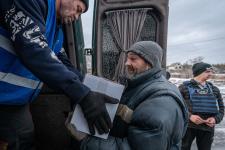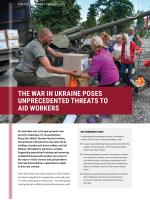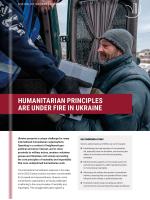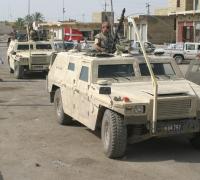Humanitarian principles are under fire in Ukraine

Donors, policymakers and NGOs can work towards:
- Establishing clear demarcation of humanitarian aid, especially near the frontlines, and ensuring the safety of aid workers with discreet branding strategies.
- Reinforcing the capacity of civil society actors for autonomous operations, while maintaining clarity on humanitarian standards.
- Advocating for policies that protect humanitarian workers, ensuring they can operate without undue influence from military or political pressures.
- Pushing for sector-wide humanitarian reform concerning the core principles that guide aid delivery.
The international humanitarian response in the wake of the 2022 Russian invasion has been commendable for its speed and resourcefulness. However, some humanitarian organizations are facing challenges in adhering to the core principles of neutrality and impartiality. This struggle takes place against a backdrop where Western donors, governments, and citizens have expressed strong political and moral views on the war. Additionally, professional humanitarians find themselves working alongside a wide spectrum of foreign volunteer groups and a highly engaged Ukrainian civil society. This can complicate humanitarian operations, particularly close to the contact line where there is the added complexity of working in close proximity to military units. Based on insights from field research conducted in Ukraine including interviews with humanitarian staff, this brief outlines the ways in which neutrality and impartiality among humanitarian actors in Ukraine are challenged and in some cases compromised. Following this, the brief also looks at the implications for future humanitarian work in Ukraine and other conflict zones.
International and Donor Pressures
Not only do many humanitarians feel a deeper personal, political and moral commitment to the Ukrainian cause, the stark political interests demonstrated by many of their donors are also unprecedented. A number of experienced humanitarians reported that they had never worked in a situation where geopolitical interests, donor preferences and funding mechanisms were so explicitly aligned. This is a new development even in Ukraine. Several humanitarians who had worked in the region since 2014 highlighted how the 2022 invasion has critically compromised the neutrality that once underpinned humanitarian work in Ukraine.
Neutrality might be dismissed as Western-centric, bypassing local cultural and societal norms, or its waning relevance viewed as an understandable reaction to Russian aggression. Nonetheless, professional humanitarians are obliged by both their organizations and their donors to follow these principles and can face professional and personal dilemmas in the field as a consequence of their erosion. Moreover, losing the perception of neutrality may impact on the organizations’ practical capacity to enforce humanitarian corridor access and work in newly-liberated areas, where the political reality is more complex and parts of the population collaborated with the Russian authorities.
Managing Military Proximity
The Russian invasion of Ukraine is defined by two modern state militaries separated by a 1,200km frontline. This means that in addition to political closeness, humanitarian actors also find themselves working in close geographical proximity to military actors, in some instances effectively following the frontline as it moves.
This makes sense, as some of the most acute humanitarian need is to be found close to the contact lines. Yet one challenge that delivering assistance so near to those engaged in combat presents is that of differentiating civilian aid from military support. For example, the distribution of medical aid, often as valuable to soldiers as it is to civilians, poses a moral and logistical quandary as regards ensuring that aid remains with civilian recipients. To mitigate the risk of such supplies being diverted for military use, some humanitarian workers have refrained from placing certain medical equipment in hospitals near the front lines, and strictly regulate the use of personal first aid kits by national staff who traverse into combat zones. There have also been reports of military and security forces requisitioning humanitarian vehicles. This blurring of boundaries between humanitarian and military activity, supply and logistics, can have important implications not only for adherence to principles of neutrality, but also practical safety and security in the field.
Volunteers muddle the picture
The Ukrainian conflict, due to its proximity to Europe and the charged political context, has become a magnet for an array of volunteer groups. The contributions of these volunteers have greatly helped both civilian relief and military support efforts. Yet, professionals within the humanitarian sector operating in the same space have articulated concerns regarding the varied backgrounds and informal status of these volunteers, and the fact that their presence contributes to the complications around neutrality and impartiality. The lack of standardized training and needs assessment among these groups stands in stark contrast to the rigorous protocols followed by established organizations, which are bound by strict operational structures and risk assessment procedures.
The term “volunteer” itself has become somewhat ambiguous, sometimes stretched to include military personnel and foreign fighters with Ukraine’s International Legion. Some in the sector view this leading to a dilution of humanitarian identity and status. This labelling is particularly complex in areas such as demining, where some foreign military veterans have banded together as volunteers. With altruistic intentions, they nonetheless work very close to the frontlines, and develop close relationships with military authorities. This ambiguity is not limited to those providing aid; it also affects those receiving it, with instances of the term “volunteer” being ambiguously applied to both civilian and military recipients. In one case, an international NGO established a soup kitchen intended for ‘volunteers’ which they later realized was serving soldiers based on their local partner’s interpretation of the term.
A recent law mandating volunteers to pay taxes signals the government’s intention to professionalize and regulate the volunteer sector. However, the ambiguity surrounding the allocation of these taxes – whether to government funds or direct war support –reflects the fluidity of the volunteer sector amid the conflict. While the initial surge of such informal volunteers has waned, the implications of their involvement, the confusion they bring to the humanitarian lexicon, and the challenges faced as regards maintaining strict humanitarian principles persist as an ongoing concern.
Branding and Visibility at the Front
The proximity of humanitarian operations to frontlines and the presence of a large number of volunteers have led to organizations increasingly being perceived as targets by military forces, and sparked some debate over the visibility and vulnerability of humanitarian entities.
It is not uncommon to see volunteers in full military clothing, even in Kyiv, and there were numerous reports of unregistered volunteer groups painting their vehicles in military hues. This heightens the risk profile for humanitarian organizations, especially close to the contact line where distinguishing between actual military personnel, volunteers, and NGOs is far from straightforward. A Ukrainian humanitarian security professional reported how volunteers in an unbranded black SUV wearing military attire were targeted by shelling. Similarly, others maintain that visibility has been lethal, recounting how a volunteer in a conspicuously marked white van was killed near the frontline, apparently as a result of a targeted attack. Anecdotal accounts from USAID-affiliated organizations suggest a heightened risk profile and even direct targeting. One respondent claimed that after several incidents where his organization’s warehouse and staff were deliberately targeted, they were forced to stop working so close to the frontline.
This has led to an ongoing debate among non-governmental organizations (NGOs) regarding the use of vehicle branding and attire in conflict zones. Many volunteer groups have chosen to paint their vehicles, including ambulances, in military colours in order to blend in near the frontlines. They also wear attire that resembles military clothing, partly to blend in and partly because it looks impressive.
The dilemma of branding also reflects the internal dynamics within INGOs, especially between programme implementation and security management. One humanitarian security manager prefers subdued branding to enhance safety but faces challenges reconciling this with the programme side of his organization, which desires visible branding to promote the organization, particularly in high-risk areas.
Organizations like the ICRC, which are protected under the Geneva Convention, are unlikely to remove their emblem. However, they face a different problem, with some reports that the iconic Red Cross logo has been misappropriated by various actors, including volunteer groups attempting to navigate checkpoints more easily, thereby complicating security and brand integrity.
Currently, there is a mix of branded humanitarian vehicles that are easily noticeable close to the frontlines, and military-looking vehicles that are indistinguishable from military assets. Some humanitarians propose a solution in the form of a third option: using regular cars without any NGO branding, military-related colours, or marks. In terms of visibility, staff can enter health facilities or other public institutions in civilian clothes and then put on a jacket or vest with the NGO logo. Food or medical distributions can remain labelled with the logo.
Working with Civil Society
The final area of interest concerns Ukraine’s extensive and engaged civil society, where a significant portion of the population is engaged in providing both military and civilian aid to the armed forces. The conflict has catalysed the formation of numerous local NGOs.
For instance, in Kharkiv, ad hoc volunteer groups transitioned into NGOs to secure grants and build partnerships with INGOs. This is an emerging area of international support. Within the United Nations framework, there exists a Ukrainian Humanitarian Fund (UHF) that enables organizations like the Danish Refugee Council (DRC) to obtain grants for capacity-building projects, thereby enhancing local NGO operations.
Encountering a robust civil society in a conflict zone is a novel experience for many humanitarians. While it offers great benefits—such as community integration, a strong local presence, and valuable insights into the local context—it also presents challenges in the area of upholding humanitarian standards, accountability, and transparency. Some humanitarians observe that the erosion of neutrality has worsened as the conflict has unfolded and suggest that the situation in Ukraine should instigate a critical reassessment of the localization concept.
National staff understandably find it difficult to remain neutral amid the intensifying conflict. Consequently, civil society organizations often engage more directly with conflict actors, at times do not differentiate between military and civilian aid beneficiaries, and individual local staff may support the military outside of their humanitarian roles. In a war of occupation with a clear aggressor, a binary perspective tends to pervade where one is perceived as either a staunch ally or an opponent. This challenges the principle of neutrality, particularly in situations where International Humanitarian Law might be at stake. The digital dimension adds another layer of complexity, with national staff sometimes sharing online content that may be deemed insensitive, reflecting the deep-seated trauma inflicted by the conflict.
A lack of clarity
The debate on humanitarian neutrality is not new to Ukraine, and it is becoming increasingly accepted that humanitarian work is inherently political, especially in conflict zones. In Ukraine, many newly-established NGOs and informal volunteer groups do not view neutrality as a relevant principle. Yet the strong public and political interest and extensive media coverage means that there is an opportunity to initiate a broader conversation on the core principles that ostensibly guide international humanitarian work. However, organizations should be comfortable in speaking publicly about the need for greater or lesser impartiality. Currently, a lack of clarity on expectations around neutrality and impartiality puts individual humanitarians in difficult positions and compromises aid delivery and security, especially at the frontline.
DIIS Eksperter



